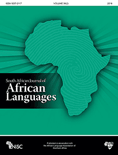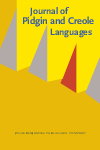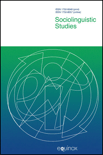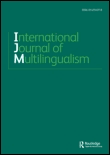
South African Journal of African Languages
Scope & Guideline
Pioneering research in the vibrant world of African linguistics.
Introduction
Aims and Scopes
- Language Documentation and Analysis:
The journal publishes research that documents and analyzes various African languages, including their grammatical structures, phonetics, and sociolinguistic contexts. - Language and Education:
It explores the intersection of language and education, particularly how African languages are utilized in educational contexts and the implications for language policy and literacy. - Cultural and Societal Implications of Language:
The journal examines how language shapes cultural identity and social dynamics, focusing on issues such as language rights, language attitudes, and the role of language in community engagement. - Translation and Interpretation Studies:
Research on translation practices, challenges, and methodologies in the context of African languages is a core component, emphasizing the importance of accurate representation in multilingual societies. - Linguistic Innovation and Change:
The journal highlights studies on linguistic innovation, including code-switching, language contact phenomena, and the evolution of language in contemporary settings.
Trending and Emerging
- Language Rights and Policy:
There is an increasing focus on language rights, including the evaluation of language policies and their impacts on communities, particularly marginalized language groups in South Africa. - Digital Linguistics and Technology:
Research exploring the intersection of language and technology, including the use of AI in language development and digital communication, is gaining traction. - Sociolinguistic Perspectives on Identity:
Emerging themes explore how language interacts with identity, particularly in relation to immigration, gender, and socio-political contexts, reflecting ongoing societal changes. - Indigenous Knowledge and Language:
An emphasis on the role of indigenous languages in conveying cultural knowledge and practices is on the rise, highlighting the importance of language preservation. - Language in Popular Culture:
There is a growing interest in how African languages are represented and used in popular culture, including music and media, reflecting broader social trends.
Declining or Waning
- Historical Linguistics:
Research focusing on the historical development of African languages is less frequently published, suggesting a possible shift towards more contemporary linguistic studies. - Linguistic Theory Application:
There appears to be a decline in papers applying traditional linguistic theories to African languages, indicating a move towards more applied and practical linguistic research. - Comparative Linguistics:
Studies that compare African languages with non-African languages have decreased, possibly reflecting a growing emphasis on internal language dynamics rather than cross-linguistic comparisons.
Similar Journals

Linguistics of the Tibeto-Burman Area
Exploring the Rich Tapestry of Tibeto-Burman LinguisticsLinguistics of the Tibeto-Burman Area is a premier journal dedicated to the study and exploration of the Tibeto-Burman languages, offering a significant platform for researchers, scholars, and practitioners in the field of linguistics. Published by John Benjamins Publishing Co, this journal not only maintains rigorous scholarly standards but also aims to contribute to the understanding of language diversity and evolution within the Tibeto-Burman region. With an impressive Q2 ranking in linguistics and language, it ranks in the 49th percentile within Arts and Humanities and the 45th percentile in Social Sciences, highlighting its relevance and quality in the academic community. Since its inception in 2011, the journal has been at the forefront of disseminating research that encourages interdisciplinary dialogue and fosters insights into language structure, use, and cultural implications. Though not an open access publication, it remains accessible to institutions and individuals alike, ensuring that vital academic discussions continue. The ISSN for print is 0731-3500 and for the electronic version, 2214-5907, facilitating the work of the growing scholarly community engaged in Tibeto-Burman linguistics.

Euskera
Illuminating the Path of Basque Linguistic ResearchEuskera is a distinguished academic journal dedicated to the study and promotion of the Basque language and culture, published by EUSKALTZAINDIA, the Royal Academy of the Basque Language. With the ISSN 0210-1564, this journal serves as a pivotal platform for researchers, linguists, and cultural scholars to disseminate cutting-edge research and discussions focused on linguistics, language preservation, and Basque identity. Although the journal is not classified as Open Access, it provides comprehensive insights into the advancement of Basque studies and contributes significantly to the field’s academic discourse. Aimed at fostering a deeper understanding and appreciation of the linguistic and cultural heritage of the Basque people, Euskera plays an invaluable role in connecting scholars and practitioners, promoting vibrant scholarly exchanges that enrich both local and global perspectives.

JOURNAL OF PIDGIN AND CREOLE LANGUAGES
Unveiling the Dynamics of Language and IdentityJOURNAL OF PIDGIN AND CREOLE LANGUAGES, published by John Benjamins Publishing Co, is a leading international journal dedicated to the study of pidgin and creole languages, offering a unique platform for interdisciplinary research within the fields of linguistics and language studies. With an impressive impact factor reflected in its 2023 Scopus rankings—placing it in the Q2 category for both Linguistics and Language—this journal has established itself as an essential resource for academics and practitioners alike. Covering a broad temporal scope from 1986 to 2024, it promotes innovative research that advances the understanding of language evolution, socio-linguistics, and cultural dynamics. The journal’s focus on both theoretical and practical perspectives makes it particularly valuable for researchers, professionals, and students interested in the complexities of language and identity. Although it does not currently offer Open Access, its commitment to quality scholarship ensures that each issue presents cutting-edge research and critical insights into the world of pidgins and creoles.

Sociolinguistic Studies
Unraveling the Tapestry of Language and IdentitySociolinguistic Studies, published by EQUINOX PUBLISHING LTD, is a premier academic journal dedicated to advancing the understanding of language in its social context. With an ISSN of 1750-8649 and an E-ISSN of 1750-8657, this journal plays a vital role in the fields of linguistics, sociology, and political science, offering a platform for interdisciplinary research that bridges diverse theoretical frameworks and methodologies. Since its inception in 2008, the journal has remained committed to publishing high-quality research that contributes to the critical engagement with sociolinguistic phenomena globally. With a categorization of Q3 in both Linguistics and Language and Sociology and Political Science as of 2023, and notable Scopus rankings reflecting its intellectual contribution, Sociolinguistic Studies is essential for researchers, professionals, and students aiming to explore the intricate relationships between language, society, and identity. Although open access is not currently available, the journal's scholarly impact continues to grow as it shapes contemporary discussions in sociolinguistics through rigorous peer-reviewed articles.

Heritage Language Journal
Illuminating the Path of Linguistic DiversityThe Heritage Language Journal is an esteemed publication dedicated to the field of heritage language studies, providing a platform for advanced research and discussions surrounding bilingualism, language maintenance, and cultural identity. Published by BRILL, a recognized leader in academic publishing, this journal aims to bridge the gap between theory and practice, offering insightful articles, empirical studies, and critical reviews that advance understanding of how heritage languages influence personal and community identity. With an ISSN of 1550-7076, the journal serves as an essential resource for researchers, professionals, and students engaged in linguistics, sociolinguistics, and multicultural studies. Although currently not an open-access journal, it maintains rigorous academic standards and is committed to fostering an inclusive dialogue on heritage languages worldwide. Additionally, by contributing to the ongoing discourse in this vital area of study, the Heritage Language Journal plays a significant role in preserving linguistic diversity and cultural heritage.

Eurasian Journal of Applied Linguistics
Connecting Scholars to Transform Language PracticesThe Eurasian Journal of Applied Linguistics, published by Hacettepe University, ELT Department, is a distinguished open-access journal that has been contributing to the fields of linguistics and language education since 2015. With a focus on bridging cultural and linguistic understandings across Eurasia, this journal provides a platform for researchers, educators, and practitioners to share cutting-edge studies, innovative pedagogical strategies, and insightful analyses. The journal holds notable Scopus rankings within the Language and Linguistics (Rank #155/1088, 85th Percentile) and Education (Rank #696/1543, 54th Percentile) categories, evidencing its growing impact within the academic community. As it prepares to converge into a new phase from 2018 to 2024, the Eurasian Journal of Applied Linguistics aims to uphold its mission of fostering interdisciplinary dialogue and advancing knowledge in applied linguistics and its related fields.

Suvremena Lingvistika
Illuminating the Complexities of Language and Communication.Suvremena Lingvistika is a distinguished open-access journal published by the Croatian Philological Society, dedicated to advancing research in the field of linguistics and language. Since its establishment, the journal has been pivotal in promoting scholarly dialogue within the linguistics community, especially among researchers and academics in Croatia and beyond. With an ISSN of 0586-0296 and an E-ISSN of 1847-117X, the journal has transitioned to an open-access model since 2007, ensuring that research is freely accessible to all. As of 2023, it holds a respectable Q3 ranking in the Linguistics and Language category, reflecting its potential contribution to the field. The journal's scope encompasses a wide array of linguistic disciplines, encouraging both theoretical and empirical studies. Supportive of new research, Suvremena Lingvistika aims to foster innovative approaches and methodologies in linguistics, making it an essential resource for students, researchers, and professionals eager to explore the complexities of language. With its ongoing publication until 2024, it continues to shape the linguistic landscape, providing valuable insights and fostering collaboration among scholars globally.

Archivum
Cultivating a Collaborative Environment for Linguistic InquiryArchivum, published by UNIV OVIEDO in Spain, stands as a vital resource in the fields of Linguistics and Language as well as Literature and Literary Theory. With an impact factor reflective of its commitment to scholarly excellence, this journal has proudly maintained an Open Access model since 1951, ensuring that its rich repository of knowledge is freely available to researchers, professionals, and students alike. Covering a converged span from 2019 to 2023, Archivum has strategically positioned itself within the academic milieu, currently categorized in the Q4 for Linguistics and Language and Q3 for Literature and Literary Theory as of 2023. The journal is indexed in Scopus, with rankings that reflect its growing influence, such as #690 in Literature and Literary Theory and #887 in Language and Linguistics. Despite its challenges in visibility, Archivum remains essential for those seeking to engage with contemporary discussions and research within the humanities. Located in the heart of Asturias, it embodies the scholarly spirit of Spain, fostering a collaborative environment for innovation and inquiry in linguistic and literary studies.

Stellenbosch Papers in Linguistics Plus-SPiL Plus
Championing Open Access to Linguistic ScholarshipStellenbosch Papers in Linguistics Plus (SPiL Plus), published by the Department of General Linguistics at the University of Stellenbosch, is a prominent open-access journal dedicated to the dissemination of research in the field of linguistics. Established in 1980, SPiL Plus provides a collaborative platform for researchers, professionals, and students worldwide, facilitating the sharing of innovative linguistics research from diverse subfields. With an ISSN of 1726-541X and an E-ISSN of 2224-3380, this journal has secured its place in the academic landscape, despite currently holding a Q4 ranking in Linguistics and Language for 2023. It's ranked 481 out of 1088 in the Scopus metrics for Arts and Humanities and stands at the 55th percentile, confirming its relevance and contribution to the linguistics discourse. The journal aims to foster scholarly exchange and address significant linguistic issues, making it an essential resource for anyone passionate about language and its complexities. Readers can access its articles freely, promoting wider accessibility and engagement with linguistic research from South Africa and beyond.

International Journal of Multilingualism
Championing impactful research in language studies.Welcome to the International Journal of Multilingualism, a leading platform dedicated to advancing the field of linguistics and language studies. Established by ROUTLEDGE JOURNALS, TAYLOR & FRANCIS LTD and housed in the United Kingdom, this journal has rapidly ascended to a prestigious Q1 quartile status in both the Linguistics and Language categories as of 2023, ranking in the top 4% across related disciplines. With a remarkable Scopus ranking of #35 in Arts and Humanities and #38 in Social Sciences, it is recognized for publishing high-quality, impactful research that spans a diverse array of multilingual topics. The journal thrives on its commitment to examining the complexities and dynamics of multilingualism in contemporary society, making it an essential resource for researchers, professionals, and students alike. Although Open Access options are not currently available, the journal's rigorous peer-review process ensures that each publication contributes valuable insights into the field. Since its inception in 2004, the International Journal of Multilingualism continues to foster academic discourse and innovation, solidifying its role as a crucial outlet for scholarly work by 2024 and beyond.